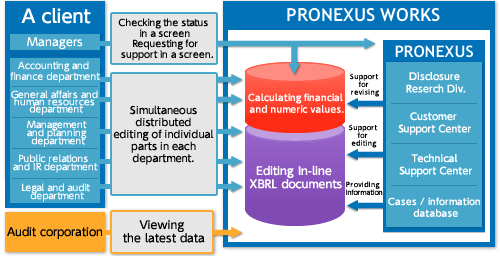Cases in Japan
![]()
The launch of the new EDINET by Financial Services Agency enabled almost all disclosure documents such as financial statements and quarterly reports to be disclosed fully in XBRL format.
Under the assumption of a complete shift to XBRL in the near future, Pronexus Inc. has been developing a system that supports creation of disclosure documents, called “Pronexus Works”, since 2008 when XBRL was first used in EDINET disclosure documents. Thanks to the great support by businessmen, the system is now being used by about 60% of listed companies.

| <The main characteristics of PRONEXUS WORKS> |
|---|
| Intuitive Editing You can edit "In-line XBRL" as if you are typing with a word processor. Most of EDINET taxonomies are automatically set by the unit of items in a table of contents, string and numeric value. Also, since special taxonomy elements including about 1000 items are provided by Pronexus, there is no need to create elements for EDINET taxonomies from scratch if they are not present. |
| Checking data The documents’ appearance and where tags are put can be easily viewed on screen and be checked through output. Pronexus Works includes many features utilizing the characteristics of XBRL that can check the following: presence of taxonomy settings without omission, consistency of instance values, units of amount, and dates such as submission day. |
| Unification of Processing Disclosure Values PRONEXUS WORKS’ optional “WORKS-I” function allows automatic calculation of a broad range of disclosure values from accounting data. These values can be transferred directly into documents edited with In-line XBRL, significantly reducing workload and lowering the risks involved in tasks such as manual transcription and visual checking. When numeric information in the form of csv files output from accounting software or consolidated accounting software is loaded into PRONEXUS WORKS, it can be converted and calculated (for example, aggregation and breakdown of items) and input into XBRL instances with a single operation. |
![]()
![]()